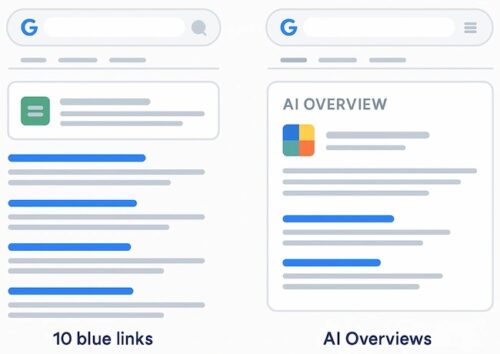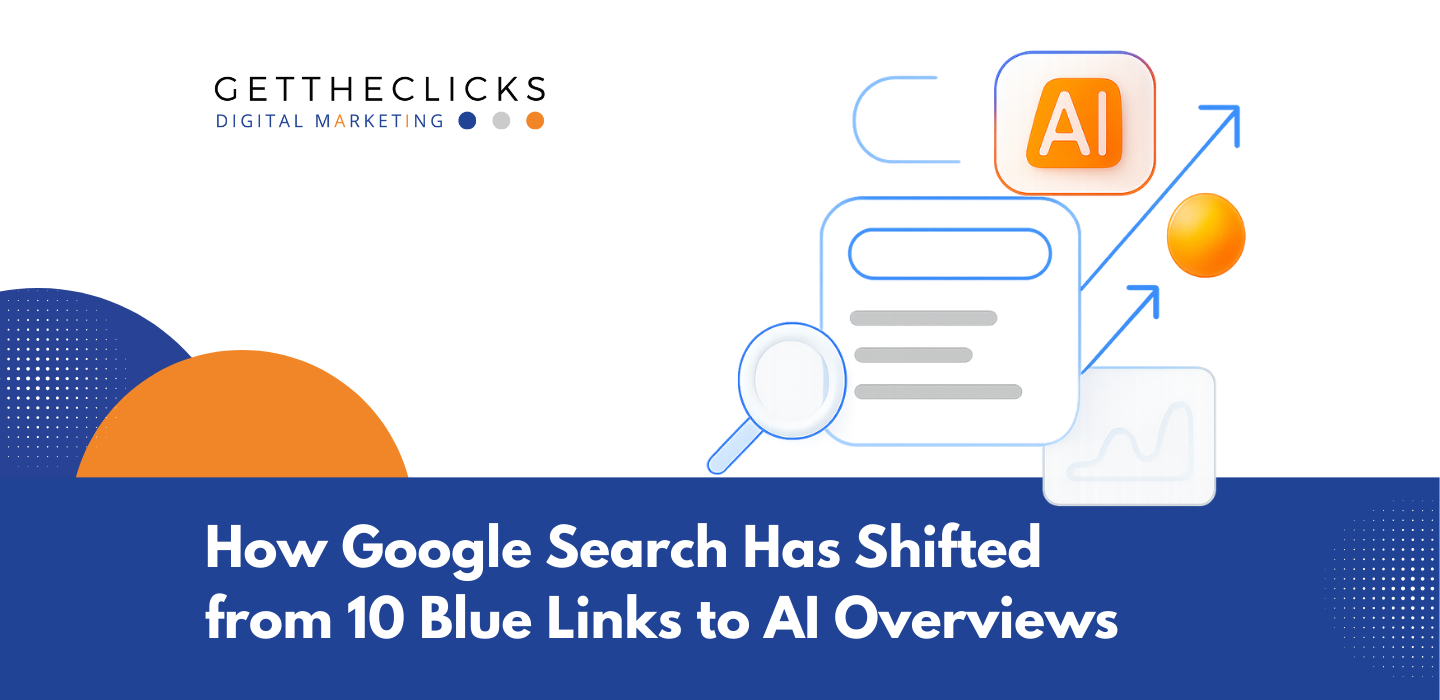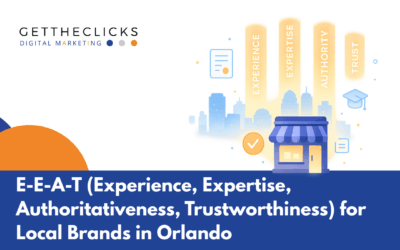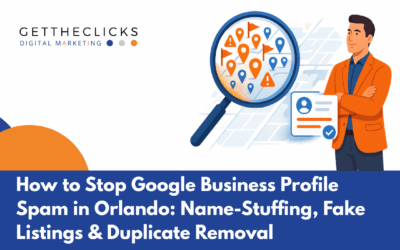Imagine you need a new washing machine. In the past, you might type a query into Google and scroll through pages of 10 blue links, reading reviews and comparisons on multiple websites. Today, an AI-powered Google search can synthesize those reviews and deliver a single, convenient overview answer in seconds. Google’s search results page – the single most-visited page on the internet – is undergoing perhaps its most radical change in 25 years. This shift from a list of webpage links to AI-generated answers is fundamentally altering how people find information, and it’s already impacting how businesses attract and engage customers online.
The Shrinking SERP – From 10 Blue Links to AI Answers
 For decades, a Google search for most queries would display a straightforward list of ten organic results (the classic “ten blue links”). Those days are ending. Google has gradually filled the search engine results page (SERP) with rich features – from Knowledge Graph info boxes to featured snippets – that provide answers directly on Google. The new AI Overview takes this to another level. When you search now using Google’s generative AI option (also formally known as the Search Generative Experience, or SGE), the familiar blue link results only appear briefly before being pushed far down the page by a large AI-generated summary box. In fact, on some queries, Google now shows fewer than ten traditional links on the first page at all. The result is a dramatically shrunk organic search real estate:
For decades, a Google search for most queries would display a straightforward list of ten organic results (the classic “ten blue links”). Those days are ending. Google has gradually filled the search engine results page (SERP) with rich features – from Knowledge Graph info boxes to featured snippets – that provide answers directly on Google. The new AI Overview takes this to another level. When you search now using Google’s generative AI option (also formally known as the Search Generative Experience, or SGE), the familiar blue link results only appear briefly before being pushed far down the page by a large AI-generated summary box. In fact, on some queries, Google now shows fewer than ten traditional links on the first page at all. The result is a dramatically shrunk organic search real estate:
- Fewer organic listings are visible on page one of Google, sometimes well below the initial viewport.
- AI overview answers consume the premium top-of-page screen space that used to be occupied by the first few organic links.
- Click-through rates are declining – even a #1 ranked page now gets a smaller share of clicks if an AI summary is answering the query.
Multiple studies confirm this new reality. When Google places an AI-generated summary at the top of the results, users become far less likely to click any of the underlying website links. Overall, Google search click-through rates (CTR) have plummeted by around 30% in the past year, even as total search impressions grew – a change attributed directly to the introduction of AI overview answers siphoning user attention. In other words, many users get the information they need from Google’s AI results without ever leaving Google’s platform. This continues a trend of “zero-click searches” that has been growing for years, in which a majority of searches end without a click onto any external website. For businesses that have long relied on organic Google traffic, this shift is a wake-up call. Marketing tip: Instead of chasing just individual keywords, focus on building topic authority. Deep, well-structured content on a subject increases your chances of being cited or used as a source in Google’s AI overviews. In a world where the AI might quote one or two definitive sources for an answer, being the trusted source on a whole topic is more valuable than ranking for one keyword.
AI Overviews vs. Ads: Google’s Balancing Act
Google’s new AI overviews don’t just disrupt organic results – they also raise questions about the future of ads on the results page. Up to now, Google has tread carefully, often suppressing AI answers on queries that are lucrative for advertisers. Recent data indicates that Google rarely displays an AI summary alongside paid search ads, with only about 5% of search results pages featuring pay-per-click ads and an AI overview. This suggests that Google has been protecting its advertising business, ensuring that the AI results don’t displace the sponsored links for high-commercial intent searches (like “insurance quotes” or “hotels in New York”). However, this may be only a temporary strategy. Google faces a classic innovator’s dilemma: if it holds back too much on AI integration to preserve short-term ad revenues, it risks losing users to competitors that offer more complete AI answers. Users are increasingly drawn to AI-first search experiences, as seen with the popularity of tools like ChatGPT and other chatbot-style search assistants, which deliver quick, context-rich answers. If a user searching for “best CRM software for startups” expects an instant AI-curated recommendation and Google instead shows a page full of ads and links, that user might turn to an alternative AI-based search tool. Google appears to recognize this tension. The company has reported that its AI overview feature has been highly successful from a user standpoint – one of the most successful launches in Search in the past decade, by Google’s own account. In Google’s largest markets (like the U.S.), the presence of AI overviews has led to users spending more time searching: Google saw over a 10% increase in search activity for queries where the AI overview is available. In other words, users like these AI answers and use Google even more when they get quick AI-driven results. This strong user engagement gives Google a long-term incentive to expand AI overviews into more query types. We should expect Google to begin showing AI answers for more commercial and high-value searches in the near future, even if it means rethinking how ads appear. Google is already experimenting with new formats – for example, testing ads inside the AI summaries in some cases. It’s a delicate balance: Google must satisfy users’ expectations for rich, instant answers while finding ways to continue featuring paid results. The evolution is ongoing, but the direction is clear: synthesized AI answers are becoming a core part of Google’s search experience, and eventually, they will be present even when you search for products and services, not just simple factual questions. Marketing tip: Prepare for a “click-less” world. If you rely on Google ads, keep a close eye on these experiments. AI overviews may begin to share the stage with sponsored content. Businesses should start treating AI summary results as a new kind of competitive space, akin to the top ad slot. That means your content strategy should aim to win visibility both in organic AI summaries and in any new ad formats Google introduces within those AI-driven results.
AI Answers Dominate the Top of the Funnel
Not only are AI overviews changing where users click (or don’t click), they’re also changing how users research and discover information in the first place. Many informational or early-stage queries – the kinds of questions potential customers ask at the top of the sales funnel – are now answered directly by Google’s AI or other AI assistants. A user can ask a broad question like “How do solar panels work?” or “What’s the best type of coffee maker for an office?” and get a detailed answer immediately, without needing to visit multiple websites for basic explanations. This means customers are learning about products and solutions straight from aggregated AI responses, often drawn from many websites but presented in one cohesive narrative. In the past, a customer might read a few blog posts or a Wikipedia article to educate themselves (giving those sites valuable traffic and a chance to promote their brand). Now, the AI might pull the key points from all those sources and display them on Google’s page. The user gets their answer and might refine their query or ask a follow-up, again to the AI, rather than clicking through to any one source. In Google’s generative search experience, follow-up questions can be suggested and answered in a conversational mode, keeping the user engaged with Google as the oracle of information. For businesses, this shift reinforces the importance of being part of the conversation early. Even if the user isn’t clicking to your site, you want your brand or insights included in that AI-generated answer. If, for example, you’ve published a highly authoritative guide on coffee makers and the AI overview cites it, your information is reaching the customer even if they never visit your page directly. The upside is that the AI can surface niche experts and quality content that might not have been rankable in the top 3 results before. The downside is that brands lose some control over the context and don’t get the click or lead – they only get a mention. Savvy consumers may notice the source and gain awareness of your brand, but it’s a more indirect form of exposure. Marketing tip: Optimize for presence, not just clicks. Ensure your content is comprehensive and credible so that Google’s AI might choose it as a trusted source. This includes answering common user questions clearly (perhaps in an FAQ style or with concise summaries) and using structured data where appropriate. Even if you don’t get the immediate traffic, being referenced in an AI answer can build brand recognition and authority. It’s similar to being quoted as an expert in a news article – it builds trust, which can pay off later in the customer journey.
Redefining Success: Impressions Over Clicks
These changes are forcing a rethink of SEO and marketing metrics. Traditionally, success in SEO was measured by rankings and clicks – how high your site ranked on page one, and how much organic traffic you got from those positions. Now, a page might rank high and technically be “visible” on the SERP, but still receive far fewer clicks because users got their answer from the AI overview or other zero-click features. Marketers are noticing that while their content’s impressions (appearances in search results) may remain robust or even increase, the click-through rates and actual visits to their site are dropping. BrightEdge (an enterprise SEO platform) reported that total search impressions have skyrocketed by nearly 50% year-over-year. Still, organic CTR has fallen by about 30% in the same period due to the impact of AI answers. Essentially, Google can show your content (or at least a snippet of it) to more people now via AI summaries and other rich results, even if those people don’t end up clicking through to your page. Your brand might be getting seen by a larger audience while your web traffic shrinks. Because of this, businesses need to adjust what they consider “SEO success.” It’s no longer just about getting that #1 ranking and expecting a flood of clicks. As one industry expert put it, “SEO is no longer just about ranking – it’s about being recommended and cited” in the new AI-driven search results. Going forward, being featured in an AI overview or other enriched result is a win in itself, even if it doesn’t yield an immediate click. It means your content was deemed authoritative enough to be included. The focus shifts from pure traffic generation to brand visibility and trust-building within the search experience. So, how can companies adapt? First, continue using tools like Google Search Console to monitor your performance, but look beyond just clicks. For instance, if you see certain pages have high impressions but low clicks, that could mean Google is using those pages in an AI overview or a featured snippet. It’s a signal that the content is relevant – and that users might be getting what they need without clicking. Consider refining the content to include a call-to-action or compelling reason to click within the snippet that appears on Google (where possible), such as offering unique value beyond the basic answer. Second, start tracking new metrics. Some marketers are experimenting with tracking how often their brand or content is mentioned by AI platforms (Google’s SGE, Bing’s chat, ChatGPT plugins, etc.). This is a nascent area, but it speaks to a broader strategy: treat the AI as another audience to optimize for. Just as we once optimized to please Google’s ranking algorithm, now we must also optimize to please Google’s answer algorithm. This means ensuring the AI can easily digest our content (clear structure, concise summaries, well-labeled sections) and understand that it’s authoritative (backed by data, expertise, and maybe even showing positive user engagement). Finally, businesses should invest in brand building and retention. When fewer visitors reach your site, it becomes vital that those who do click through find value and have a memorable experience. And for those who only see your name in a Google AI blurb, make sure your branding (the way your site is titled/described) is compelling and trustworthy. For example, if your company name appears as the source for an answer about coffee makers, a user might later search your brand name directly if they found the info helpful. That’s a win that comes not from a direct click, but from impression-based brand recognition.
Embracing the New Search Landscape
Google’s evolution from ten blue links to AI-driven overviews is a double-edged sword for businesses. On one hand, it challenges the status quo of digital marketing – strategies that worked for decades (like obsessing over page-one rankings for every keyword) are becoming less effective. On the other hand, it opens up new opportunities: a small business with expert content has a chance to be highlighted by Google’s AI, even if they don’t have the top traditional ranking. The playing field is being leveled in some ways by algorithms that seek the best answer, not just the best-optimized website. To succeed in this new environment, companies should: Create truly valuable, authoritative content that AI wants to pick up. Surface the most important information up front. Answer common questions clearly and accurately. Depth is good, but clarity is crucial – the AI needs to understand your content to use it. Adapt your SEO metrics and KPIs. Track impressions, brand mentions, and engagement, not just clicks. A spike in impressions with flat clicks isn’t necessarily failure – it might mean you’re being seen in AI overviews. Learn to connect those impressions to other outcomes (like branded search growth or offline conversions) to get the complete picture of your marketing efforts. Monitor the rollout of new AI features and ad integrations. Google’s search is still changing rapidly. Features like the dedicated AI Mode in Search, new interactive Q&A formats, or ads within AI answers can impact your strategy. Stay informed via trusted industry sources and Google’s own announcements, and be ready to experiment with new content formats or campaign approaches as Google Search transforms. Double down on brand trust and awareness. In a world where users might get their answers without clicking, having a strong brand becomes even more critical. If people recognize and trust your name when it appears in an AI-generated answer, that impression can eventually lead them to seek you out. Strategies like content marketing, social media engagement, and community building can strengthen your brand so that when your name surfaces in search, it carries weight. The era of AI-assisted search is here, not in some distant future, but right now. Google is continually refining its AI overview algorithm and expanding its reach. The familiar list of blue links isn’t gone yet, but it’s no longer the star of the show. As business owners and marketers, staying visible means evolving along with Google. By focusing on authoritative content, adjusting expectations on traffic, and prioritizing visibility and credibility, you can maintain a strong presence even as the ground shifts. In the end, the goal remains the same: connect with your audience. The mediums and metrics may change, but companies that provide genuine value and adapt to user behavior will find ways to thrive in the new search landscape.
Sources
- Google (2025) – “AI in Search: Going beyond information to intelligence.” Official Google Search Blog, May 20, 2025.
- The Verge (2023) – “Google wants you to forget the 10 blue links.” Jay Peters, The Verge, May 12, 2023.
- SparkToro (2025) – “The Case for Zero-Click Content in a Zero-Trust Ecosystem.” Amanda Natividad, SparkToro Blog, July 23, 2025.
- Search Engine Land (2025) – “New Google AI Overviews data: Search clicks fell 30% in last year.” Danny Goodwin, Search Engine Land, May 15, 2025.
- Semrush (2024) – “We Studied 200,000 AI Overviews: Here’s What We Learned.” Luke Harsel, Semrush data study, Oct 30, 2024.





